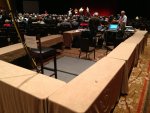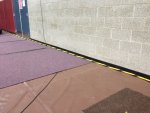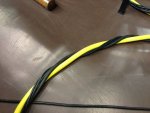Re: X32 Discussion
AES50 is a rock-solid connection and used by Midas with their Klark Teknik SuperMac technology. There are no known issues with the protocol and the technology. If ever this can only be related to cable or connection problems.
Hi Jim,
Thanks for this good note, which is just what I wanted to hear.
I appreciate the PM and offer to discuss offline, but think that this is an issue of interest to the group and would prefer to discuss it here. If there is a reason you would prefer not to, I'd be happy to discuss offline with the understanding that I can report back to the group what we find.
To partially answer your questions about my application, note that this has only happened once to me so far, and that I could try to replicate it in my shop and will, but am trying to do a year's worth of bookkeeping in a few days so my accountant will have some way to tell me how much to pay the government next month. Posting in this thread has been almost my only relaxation the past few days.
That said, here is a pic of the location where it happened, and some closeups of a snake with the same components of the snake on which it occurred, and I'll highlight the differences:

The first one shows the mix position, with the flown snake coming down from the ceiling and then going under the line of tables to get to the console. The guy on the left at the console is "my" awesome FOH engineer, Allan; not sure who is on the right or on stage.
As mentioned earlier in a post, the table legs are kind of a ] on its side, so there is a low space underneath through which I ran the snake. The gap is maybe 2 or 3 inches tall.
The snake has three components: a yellow 12/5 SOOW carrying UPS'd power for the console, and a separate circuit of AC for incidental usage; a four-pair XLR analog cable for Clearcom or whatever; and in this case two Belden Data Tuff Ethercon cables.
Here is a recap of what I wrote in reply to Michael Roper, who actually brought up the issue and reminded me of this incident:
=====================================
TecNec Neutrik Ethercon / Belden Data Tuff CAT5e Cable Assemblies by TecNec CAT-5 Cables at Markertek.com
The mess* was running under some tables that had legs that looked like ] laying on its side, making a low space below the crossbar. The cable mess was kind of coiled but not kinked, and I pulled on it to pull it through the space under the leg assembly to straighten it out.
The PA which was on, emitted a burst of pink noise sounding stuff, and stopped when I stopped pulling. I pulled again, and it did it again.
My FOH engineer, who is one of the most experienced PA techs in the NW if not the world, and I looked at each other, and he was as baffled as I. He said maybe the dynamic kinking of the cable was enough to interrupt the sync? But neither of us had a better explanation, and the cable had tested out OK earlier with a Greenlee tester. I bought this cable because it purports to be one of the toughest CAT 5 cables available.
The cable assembly/mess was where it needed to be by that time, and we left it alone, and it performed perfectly for the rest of the 5 days with no more bursts of anything.
=======================================
*For this post, I'll clarify that the "mess" was a group of separate cables running together rather than the taped or coiled mass that I prefer to create. The next couple of pics show the same components, plus one more Data Tuff cable, assembled into a single unit:


This is a different cable in a different location on an equally interesting gig that also deserves a post, but you can see the components perhaps more clearly. The three data cables are twisted into a rope-like thing, and then the two smaller are wrapped around the larger to create a highly visible yet easily manipulate-able object, rather than a collection of separate things. The loose cables of the first snake can get tangled big-time, especially if you add a lighting DMX cable that has to be removed on loadout, as happened to us.
The first snake was like it was because the Gepco Tactical that I'd ordered was out of stock, and the gig had to have snakes, so I got the Belden loose cables for one stage, and some much cheaper Cat 5 without Ethercons from B&H for the other. The snake in these two pictures was at a third stage. No incidents occurred with either the B&H cable or this snake, but I didn't try to pull them under a table and neither was getting stomped on.
The process of coming up with this snake system was interesting to me, and I thought perhaps it would be worth a post, too, as it might be useful to other people. People should let me know if you want to know more, otherwise I won't waste my time on it.
Hope this helped, let me know if you have more questions.
Dan
 ~
~ ~:smile:
~:smile:


